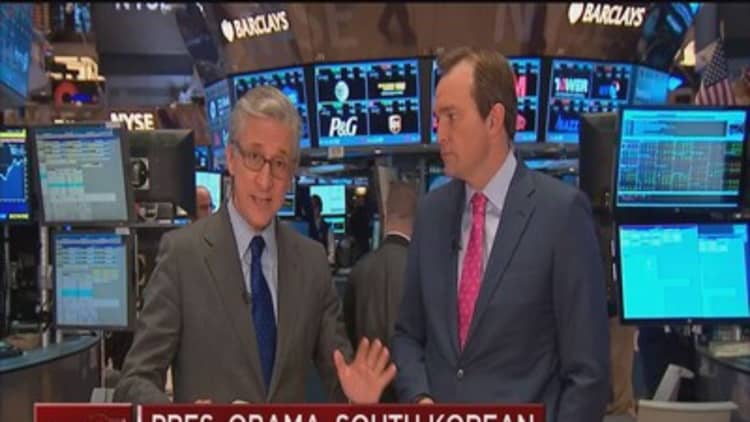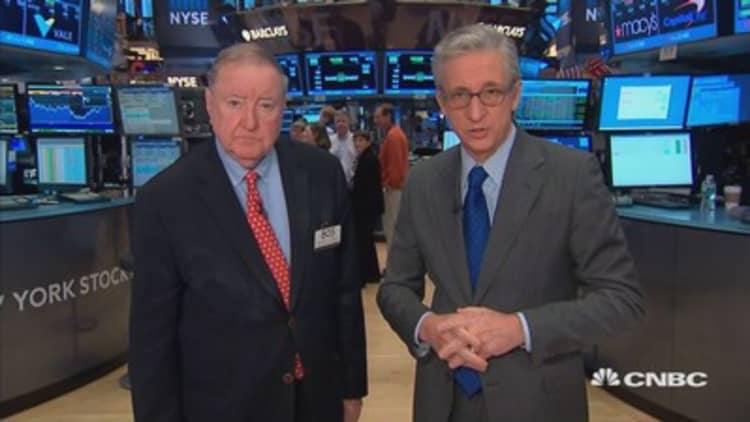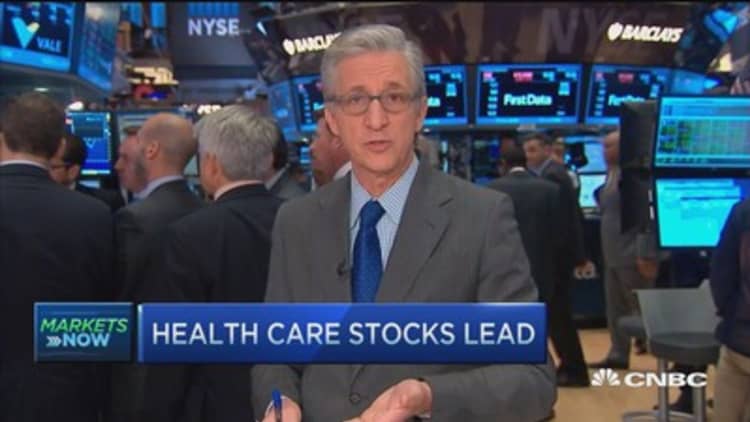



U.S. stocks closed higher Friday for a third week of gains as mixed data pushed out expectations for the timing of the first rate hike. (Tweet This)
"The data came in and emboldened investors," said Jack Ablin, chief investment officer at BMO Private Bank. "It looks like we're setting up for reasonable growth with no inflation. ... It's just more of the 'slightly bad news is good news' (because a rate hike is delayed)."
The major averages extended gains as the close approached, recovering from an intraday decline, to close up nearly 1 percent or more for the week.
The S&P 500 posted its first three-week win streak since May. The Dow Jones industrial average and Nasdaq composite had their first three consecutive weeks of gains since February.
Apple and the iShares Nasdaq Biotechnology ETF (IBB) ended lower to weigh on the Nasdaq composite.
The Dow transports closed 1.58 percent lower, with Kansas City Southern leading nearly all constituents lower. The firm reported a year-over-year decline in third-quarter revenue due to headwinds from currency and low U.S. fuel prices.
Transports ended the week down 2.1 percent, their first negative week in three.
Energy recovered losses to close mildly higher, with industrials the only declining S&P 500 sector in the close.
"I think crude settling higher puts a bit of a lift," said Dan Veru, chief investment officer at Palisade Capital Management.
"When oil is up it feels like we're really not going into a deflationary spiral," he said.
Crude oil futures settled up 88 cents, or 1.9 percent, at $47.26 a barrel after Baker Hughes data showed U.S. rigs falling for the seventh straight week. However, oil fell 4.78 percent for the week, its worst since Aug. 21.
Read MoreBad news looks good again
"After a very big day yesterday I think that was an exhaustion of a lot of the short covering," said Lance Roberts, head of Streettalklive.com. He noted Friday's session could be "very choppy and volatile" amid options expirations and ahead of the weekend.
"Yesterday the data was so weak the market immediately cued in to the fact that the Fed's not going to raise at all until 2016," he said.
Stocks rallied Thursday, with the Dow up more than 200 points and the S&P 500 closing at its highest level since Aug. 20.
Read MoreThe Fed needs to stop being delusional: trader
"We think short-term overbought conditions can be sustained for a few days, potentially allowing for a test of the 200-day moving average before a significant pullback unfolds," Katie Stockton, chief technical strategist at BTIG, said in a note.
However, she said a technical indicator suggested a lower bias to Friday's session.
In economic news, industrial production declined 0.2 percent in September, with capacity utilization at 77.5 percent.
The preliminary read on October consumer sentiment came in at 92.1. JOLTS showed 5.37 million job openings for August.
"We're sort of moving sideways on the sentiment front," said Ryan Sweet, director of real-time economics at Moody's Analytics.
"The fact that it bounced back in October — seems that it's a temporary issue," he said.
Treasury yields traded in a range, with the 10-year yield at 2.03 percent and the at 0.60 percent.
"It looks like the Treasury market is certainly in a pretty narrow range, which is not surprising given the increasing consensus on the Fed (raising rates later)," said Guy LeBas, chief fixed income strategist at Janney Montgomery Scott.
The U.S. dollar traded mildly higher against major world currencies, with the euro near $1.135 and the yen at 119.48 yen against the greenback.
Major U.S. Indexes
On the earnings front, General Electric posted earnings per share above expectations, but revenues fell short of estimates. The stock closed up 3.39 percent.
Honeywell closed down 1.49 percent after posting earnings that beat on revenue that missed, hurt by the strong U.S. dollar.
Wal-Mart shares extended declines after Wednesday's plunge to end the week down 11.7 percent, its worst since October 2008.
Shares of Twitter rose, ending up 4.85 percent, following a Bloomberg report that said former Microsoft CEO Steve Ballmer took a 4 percent stake in the company.
United Continental's stock hit session lows after a report said CEO Oscar Munoz suffered a heart attack. Shares ended down 3.1 percent.
Read More Early movers: GE, HON, TMUS, STI, PWR, LULU, T, YUM, MAT & more
In Europe, the pan-European Stoxx 600 index ended 0.6 percent higher. In Asia, Japan's Nikkei gained 1.08 percent, while the Shanghai Composite closed 1.62 percent higher.
The Dow Jones Industrial Average closed up 74.22 points, or 0.43 percent, at 17,215.97, with General Electric leading advancers and Caterpillar the greatest laggard.
The index closed the week up 0.77 percent, with Nike posting the most gains and Wal-Mart the greatest laggard.
The closed up 9.25 points, or 0.46 percent, at 2,033.11, with health care leading nine sectors higher and industrials the only decliner.
The S&P ended the week up 0.90 percent, within 5 percent of its 52-week high. Utilities was the greatest gainer for the week, while materials and industrials were the only negative sectors for the week.
The Nasdaq closed up 16.59 points, or 0.34 percent, at 4,886.69. For the week, the index outperformed the other major averages with a gain of 1.16 percent.
The CBOE Volatility Index (VIX), widely considered the best gauge of fear in the market, held near 15.
About three stocks advanced for every two decliners on the New York Stock Exchange, with an exchange volume of 960 million and a composite volume of nearly 3.6 billion in the close.
High-frequency trading accounted for 49 percent of October's daily trading volume of about 7.2 billion shares, according to TABB Group. During the peak levels of high-frequency trading in 2009, about 61 percent of 9.8 billion of average daily shares traded were executed by high-frequency traders.
Gold futures settled down $4.40 at $1,183.10 an ounce.
—CNBC's Fred Imbert contributed to this report.
Correction: An earlier version of this story misstated Roberts' site. It is Streettalklive.com.
On tap this week:
Friday
4:00 pm: Treasury International Capital
More From CNBC.com:


